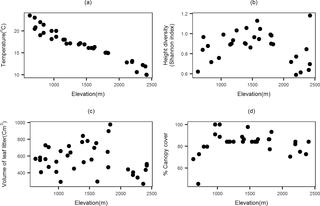Our official English website, www.x-mol.net, welcomes your feedback! (Note: you will need to create a separate account there.)
Spatial and climatic variables independently drive elevational gradients in ant species richness in the Eastern Himalaya.
PLOS ONE ( IF 3.7 ) Pub Date : 2020-01-15 , DOI: 10.1371/journal.pone.0227628 Aniruddha Marathe 1, 2 , Dharma Rajan Priyadarsanan 1 , Jagdish Krishnaswamy 1 , Kartik Shanker 1, 3
PLOS ONE ( IF 3.7 ) Pub Date : 2020-01-15 , DOI: 10.1371/journal.pone.0227628 Aniruddha Marathe 1, 2 , Dharma Rajan Priyadarsanan 1 , Jagdish Krishnaswamy 1 , Kartik Shanker 1, 3
Affiliation

|
Elevational gradients are considered important for understanding causes behind gradients in species richness due to the large variation in climate and habitat within a small spatial extent. Geometric constraints are thought to interact with environmental variables and influence elevational patterns in species richness. However, the geographic setting of most mountain ranges, particularly continuity with low elevation areas may reduce the effect of geometric constraints at lower elevations. In the present study, we test the effects of climatic gradients and continuity with the low elevation plains of the eastern Himalayan mountain range on patterns of species richness. We studied species richness of ants (Hymenoptera: Formicidae) on an elevational gradient between 600m and 2400m in the Eastern Himalaya-part of Himalaya biodiversity hotspot. Ants were sampled in nine elevational bands of 200m with four transects in each band using pitfall and Winkler traps. We used regression models to identify the most important environmental variables that predict species richness and used constrained null models to test the effects of contiguity between the mountain range and plains. We find a monotonic decline in species richness of ants with elevation. Temperature was a more important predictor of species richness than habitat complexity. Geometric constraints model weighted by temperature with a soft lower boundary and hard upper boundary best explained the species richness pattern. This suggests that a combination of climate and geometric constraints drive the elevational species richness patterns of ants.
中文翻译:

空间和气候变量独立地驱动喜马拉雅东部蚂蚁物种丰富度的海拔梯度。
高度梯度被认为对理解物种丰富度梯度背后的原因很重要,因为在很小的空间范围内气候和栖息地的变化很大。几何约束被认为与环境变量相互作用并影响物种丰富度的海拔格局。但是,大多数山脉的地理环境,特别是低海拔地区的连续性,可能会降低低海拔地区的几何约束效应。在本研究中,我们测试了喜马拉雅山脉东部低海拔平原的气候梯度和连续性对物种丰富度格局的影响。我们在喜马拉雅山生物多样性热点的东部喜马拉雅山上海拔600m至2400m的海拔梯度上研究了蚂蚁(膜翅目:蚁科)的物种丰富度。使用陷阱和Winkler陷阱在200m的九个海拔带中采样蚂蚁,每个带中有四个样带。我们使用回归模型来识别预测物种丰富度的最重要的环境变量,并使用受约束的零模型来测试山脉和平原之间的连续性影响。我们发现蚂蚁物种丰富度随海拔高度单调下降。温度是物种丰富度比栖息地复杂度更重要的指标。由温度加权的几何约束模型具有较低的软边界和较高的硬边界,可以最好地解释物种的丰富度模式。这表明气候和几何约束条件的结合驱动了蚂蚁的海拔物种丰富度模式。
更新日期:2020-01-16
中文翻译:

空间和气候变量独立地驱动喜马拉雅东部蚂蚁物种丰富度的海拔梯度。
高度梯度被认为对理解物种丰富度梯度背后的原因很重要,因为在很小的空间范围内气候和栖息地的变化很大。几何约束被认为与环境变量相互作用并影响物种丰富度的海拔格局。但是,大多数山脉的地理环境,特别是低海拔地区的连续性,可能会降低低海拔地区的几何约束效应。在本研究中,我们测试了喜马拉雅山脉东部低海拔平原的气候梯度和连续性对物种丰富度格局的影响。我们在喜马拉雅山生物多样性热点的东部喜马拉雅山上海拔600m至2400m的海拔梯度上研究了蚂蚁(膜翅目:蚁科)的物种丰富度。使用陷阱和Winkler陷阱在200m的九个海拔带中采样蚂蚁,每个带中有四个样带。我们使用回归模型来识别预测物种丰富度的最重要的环境变量,并使用受约束的零模型来测试山脉和平原之间的连续性影响。我们发现蚂蚁物种丰富度随海拔高度单调下降。温度是物种丰富度比栖息地复杂度更重要的指标。由温度加权的几何约束模型具有较低的软边界和较高的硬边界,可以最好地解释物种的丰富度模式。这表明气候和几何约束条件的结合驱动了蚂蚁的海拔物种丰富度模式。


























 京公网安备 11010802027423号
京公网安备 11010802027423号